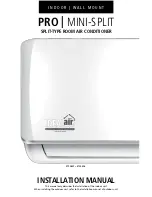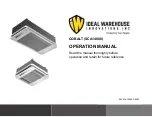
12
4.
Using the three screws provided, attach the hood (with
the opening facing down) over the flue exhaust open
-
ing in the utility panel.
SCREEN
HOOD
LOWER
FLUE
HOOD
LIP
Installation - Combustion Air Intake Hood
1. Locate the second hood.
2.
Using the three screws provided, attach the hood (with
the opening facing down) to the heat exchanger access
door.
CONDENSATE DRAIN
Condensate Drain Connection
A 3/4” NPT drain connection is supplied for condensate pip-
ing. An external trap must be installed for proper condensate
drainage.
DRAIN
CONNECTION
UNIT
2" MINIMUM
FLEXIBLE
TUBING-HOSE
OR PIPE
3" MINIMUM
A POSITIVE LIQUID
SEAL IS REQUIRED
DRAIN CONNECTION
NORMAL SEQUENCES OF OPERATION
Heating
This unit is equipped with an ignition control that automat-
ically lights the main burner. DO NOT attempt to light the
main burners by any other method.
1. Thermostat calls for low or high stage heating.
2. Induced draft blower energizes for 15-second pre-
purge.
3. The spark igniter and low and high stage gas valve are
energized for 7 seconds.
NOTE:
The igniter produces
a very intense electrical spark that ignites the gas.
4. Main burners light and control detects presence of
flame.
5. If the call is for low stage heat, the induced draft blower
switches to low speed and the high stage gas valve
closes 5 seconds after the main burners light. If call
is for high stage heat, induced draft blower remains at
high speed and high stage gas valve remains open.
NOTE:
If a single stage thermostat is used, the control
will step to low stage after the main burners light and
remain at low stage for 5 or 10 minutes, depending on
jumper position. If the call for HEAT remains after the
transition delay time expires, the control will transition
from low stage to high stage.
6. The 30-second HEAT FAN ON delay time begins after
the main burners light.
7. The unit delivers heat to the conditioned space until the
8.
Gas valve(s) de-energizes. The induced draft blower
continues operation for a 30-second post-purge.
9.
Induced draft blower remains at low speed (or switches
from high to low if operating at high stage heat) for the
30-second post purge.
10. Ignition control begins timing the HEAT FAN OFF de-
lay. There is an adjustable HEAT FAN OFF delay of
approximately 90/120/150/180 seconds (factory set at
150). If the unit is operating at high stage when the call
for heat is removed, the blower will operate for 30 sec-
onds at high heat speed then switch to low heat speed
for the remainder of the selected HEAT FAN OFF delay.
NOTE
: After the HEAT FAN OFF delay time has
elapsed, the blower will de-energize. This allows any
additional heat in the heat exchanger to be transferred
to the conditioned space.
Cooling
1. Thermostat calls for low or high stage cooling.
2. If the thermostat call is for low stage cooling, the com-
pressor and outdoor fan are energized at low stage. If
the thermostat call is for high stage cooling, the com-
pressor and outdoor fan are energized at high stage.
3. The indoor blower will energize approximately 6 sec-
onds later.
4. The unit delivers cooling to the conditioned space until
the thermostat is satisfied.
5. The compressor and outdoor fan will be de-energized
when the thermostat opens.
6. The indoor blower continues to run at low cool speed
for approximately 60 seconds after the thermostat is
satisfied. This allows additional cooling from the indoor
coil to be transferred to the conditioned space. Then,
the indoor blower is de-energized.
NOTE:
A 180-second anti-short cycle is integral to the
control and prevents recycling of the compressor.













































